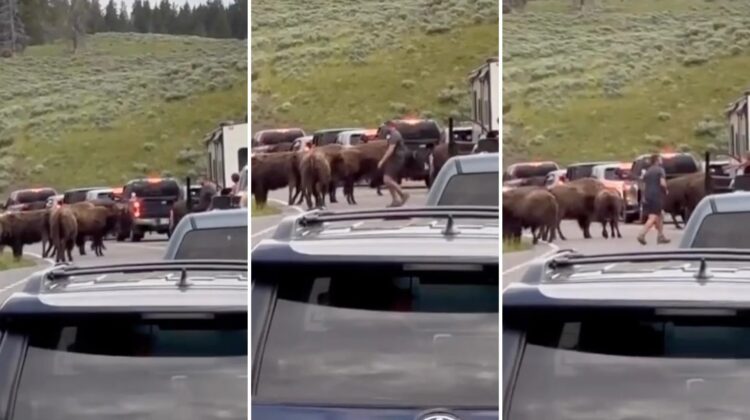
In a video recently shared on the TouronsOfYellowstone Instagram account, a troubling incident unfolded during a bison traffic jam in Hayden Valley at Yellowstone National Park. The footage, captured by Meredith Weiss Zeller, shows a line of cars at a standstill as a large herd of bison crosses the road. However, the attention quickly shifts to a tourist who, defying all safety guidelines, exits his vehicle and walks directly into the herd to pick something up from the ground.
The term “touron,” a blend of tourist and moron, aptly describes this reckless behavior that is unfortunately becoming more common. The video highlights a disturbing trend of tourists interacting thoughtlessly and dangerously with wildlife, jeopardizing both their safety and the well-being of the animals.

The National Park Service strongly advises against approaching wildlife, emphasizing that even seemingly calm animals in Yellowstone are wild and unpredictable. The safest way to view wildlife is from inside a vehicle, maintaining a distance of at least 100 yards from bears and wolves and 25 yards from other animals, including bison and elk.
The reckless actions of this particular tourist not only put himself at risk but also disrupt the natural behavior of the bison and can have severe consequences for both humans and animals. Wildlife-human interactions in national parks are a privilege, and they should foster a greater understanding of the natural world, leading to a desire to protect it rather than exploit it.
Comments on the video expressed disappointment and astonishment at the tourist’s behavior. One viewer remarked, “The bison were even stunned by the level of dim from this touron!” Such actions not only stress bystanders witnessing these events but also have the potential to lead to euthanizing animals that may become a threat to humans.
As our planet faces increasing environmental challenges, responsible tourism becomes paramount. It is crucial for visitors to national parks to prioritize safety and respect for wildlife, ensuring that these natural wonders can be enjoyed safely and without causing harm to the ecosystem or its inhabitants.

Leave a Reply